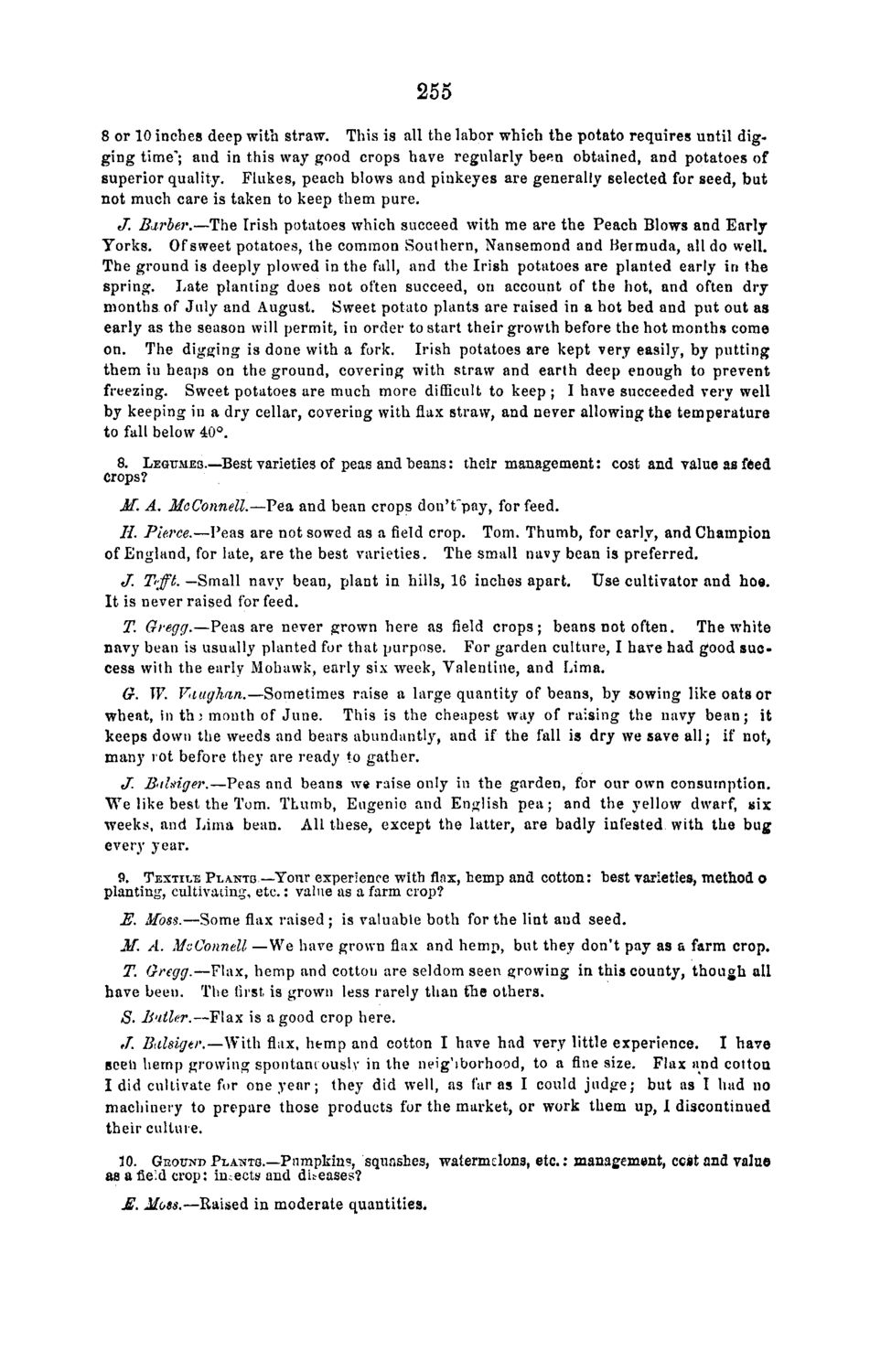| |
| |
Caption: Board of Trustees Minutes - 1868
This is a reduced-resolution page image for fast online browsing.

EXTRACTED TEXT FROM PAGE:
255 8 or 10 inches deep with straw. This is all the labor which the potato requires until digging time"; and in this way good crops have regularly been obtained, and potatoes of superior quality. Flukes, peach blows and pinkeyes are generally selected for seed, but not much care is taken to keep them pure. J. Barber.—The Irish potatoes which succeed with me are the Peach Blows and Early Yorks. Of sweet potatoes, the common Southern, Nansemond and Bermuda, all do well. The ground is deeply plowed in the fall, and the Irish potatoes are planted early in the spring. Late planting does not often succeed, on account of the hot, and often dry months, of July and August. Sweet potato plants are raised in a hot bed and put out as early as the season will permit, in order to start their growth before the hot months come on. The digging is done with a fork. Irish potatoes are kept very easily, by putting them in heaps on the ground, covering with straw and earth deep enough to prevent freezing. Sweet potatoes are much more difficult to keep ; I have succeeded very well by keeping in a dry cellar, covering with flax straw, and never allowing the temperature to fall below 40°. 8. LEGUMES.—Best varieties of peas and beans: their management: cost and value as feed crops? M. A. McConnell.—Pea and bean crops donVpay, for feed. / / . Pierce.—Peas are not sowed as a field crop. Tom. Thumb, for early, and Champion of England, for late, are the best varieties. The small navy bean is preferred. J. Ti-ffb. —Small navy bean, plant in hills, 16 inches apart. It is never raised for feed. Use cultivator and hoe. T. Gregg.—Peas are never grown here as field c r o p s ; beans not often. The white navy bean is usually planted for that purpose. For garden culture, I have had good s u c cess with the early Mohawk, early six week, Valentine, and Lima. G. W. Viiughan.—Sometimes raise a large quantity of beans, by sowing like oats or wheat, in th J month of J u n e . This is the cheapest way of raising the navy b e a n ; it keeps down the weeds and bears abundantly, and if the fall is dry we save all; if not, many rot before they are ready to gather. J. B'driger.—Peas and beans we raise only in the garden, for our own consumption. We like best the Tom. Thumb, Eugenie and English p e a ; and the yellow dwarf, six weeks, and Lima bean. All these, except the latter, are badly infested with the bug every year. 9. TEXTILE PLANTS —Your experience with flax, hemp and cotton: best varieties, method o planting, cultivating, etc.: value as a farm crop? E. Moss.—Some flax raised; is valuable both for the lint aud seed. M. A. McConnell —We have grown flax and hemp, but they don't pay as a farm crop. T. Gregg.—Flax, hemp and cotton are seldom seen growing in this county, though all have been. The first is grown less rarely than the others. S. Butler.—Flax is a good crop here. J. Balsiger.—With flax, hemp and cotton I have had very little experience. I have seen hemp growing spontaneously in the neighborhood, to a fine size. Flax and cotton I did cultivate for one y e a r ; they did well, as far as I could j u d g e ; but as I had no machinery to prepare those products for the market, or work them up, I discontinued their culture. 10. GEOTJND PLANTG.—Pumpkin?, squashes, watermelons, etc.: management, ccst and value as a field crop: injects and diseases? M. Moss.—Raised in moderate quantities*
| |